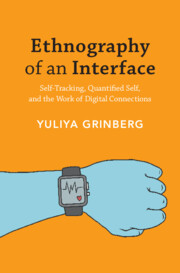Book contents
- Ethnography of an Interface
- Reviews
- Ethnography of an Interface
- Copyright page
- Epigraph
- Contents
- Preface
- Acknowledgements
- Introduction
- 1 Quantified Self and the Culture of Personal Data
- 2 Seeing Double in Digital Entrepreneurialism
- 3 Acting Like Members, Thinking Like Vendors
- 4 Hustling with a Passion
- 5 The New Normal
- 6 The Promises and Failures of Digital Connections
- Conclusion: Community at a Crossroads
- Notes
- Bibliography
- Index
- Ethnography of an Interface
- Reviews
- Ethnography of an Interface
- Copyright page
- Epigraph
- Contents
- Preface
- Acknowledgements
- Introduction
- 1 Quantified Self and the Culture of Personal Data
- 2 Seeing Double in Digital Entrepreneurialism
- 3 Acting Like Members, Thinking Like Vendors
- 4 Hustling with a Passion
- 5 The New Normal
- 6 The Promises and Failures of Digital Connections
- Conclusion: Community at a Crossroads
- Notes
- Bibliography
- Index
Summary
The camera slowly scans Chris Dancy’s face, first focusing on a profile of his bespectacled eyes, then quickly switching to a frontal shot to examine his contemplative expression at close range. Seconds later, the angle shifts again, the panorama now filmed as though from behind Dancy’s shoulder. The foreground looks blurry to start with. But once the lens adjusts, the viewer clearly sees the nearby cityscape at which Dancy longingly gazes.
Information
- Type
- Chapter
- Information
- Ethnography of an InterfaceSelf-Tracking, Quantified Self, and the Work of Digital Connections, pp. 1 - 21Publisher: Cambridge University PressPrint publication year: 2025
